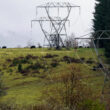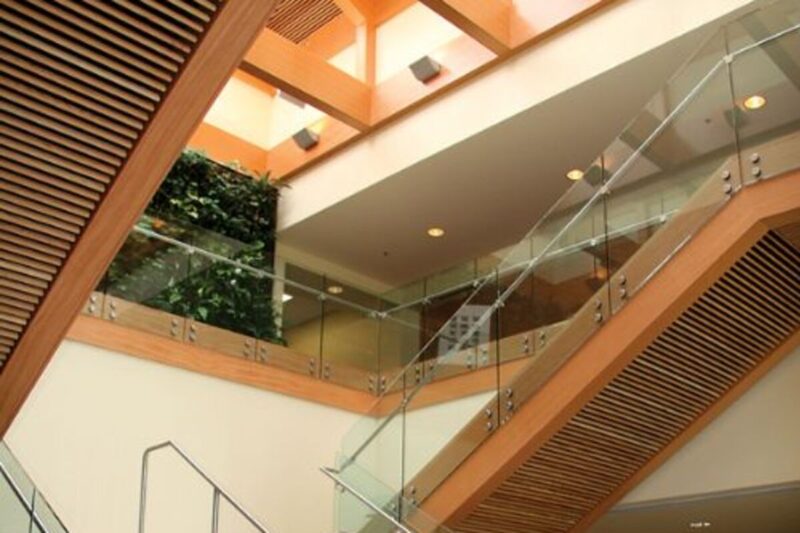Scott Swanson
The College of Osteopathic Medicine of the Pacific – Northwest will open July 30 with a traditional white coat ceremony for the 107 students in its first class. Classes begin Aug. 8.
“We were thrilled at the total number of applicants and the high academic quality of those candidates. This founding class is a talented, accomplished and dedicated group and will set the standard for all future students of COMP-Northwest,” stated Dr. Paula Crone, executive associate dean of COMP-Northwest. “We were particularly gratified that so many applicants were from Oregon and the Northwest, because our mission is to serve Oregon and the Northwest.”
Preparations have been intensifying in the last couple of weeks, with trucks backed up to the brand new two-story brick educational building located across Highway 20 from Samaritan Lebanon Community Hospital, unloading examination tables and other equipment, a film crew doing a video on the history leading up to the founding of COMP-Northwest, and a group of Sweet Home officials and residents taking a tour of the facility.
Dirk Foley, director of student services, led the Sweet Home visitors through the building, which includes cutting-edge technology that allows students to sit in a 186-seat lecture hall and listen to a lecture by a professor at Western University of Health Sciences in Pomona, Calif., the mother school for COMP-Northwest.
The group included Mayor Craig Fentiman, City Councilor Marybeth Angulo, City Manager Craig Martin and other members of the city staff, and members of various SHARE committees.
Fentiman said what he saw was “fantastic.”
“It’s a huge asset not only to the city of Lebanon but to the entire East Linn County,” he said. “I think we will see positive effects not only in Lebanon but in the surrounding area.”
Brian Hoffman, SHEDG economic development director, said the medical school has already benefited Sweet Home, noting that two of six COMP-Northwest staffers who toured Sweet Home in June already live here.
“It’s creating jobs for us,” he said. “For Sweet Home, it gives our residents a place to work. Also, I think they’ll enjoy recreating in our back yard. We also can give the students something to do.”
Foley told the Sweet Home visitors that Western began producing medical students, who came to the Northwest when it was founded in 1977, realizing that there were nearly 1 million square miles of rural areas that were underserved by osteopathic physicians. Since 2004 the Pomona school has sent 30 third- and fourth-year medical students to the Northwest, he said.
The relationship between Samaritan Health Services and Western University of Health Sciences began with the establishment of the Northwest track in 2007, in which COMP students spent the first two years in Pomona and then returned to the Northwest for clinical rotations in their third and fourth years.
Six doctors completed their first-year internship and one doctor completed his residency in June of this year.
Now, with the creation of the new school, the flow of doctors to the rural areas of the Northwest should increase, Foley and others said.
“We already had a footprint in the Northwest,” said Luke Rauch, the school’s recruitment and public relations officer, who grew up locally in the McDowell Creek area. “We’re in the process of expanding that program.”
Osteopathy, one of the two degrees recognized throughout the U.S. for the practice of surgery and medicine, is based on the belief that the body is an integrated whole, whose structure and functions are interrelated and that it has the capacity for healing itself when placed in an optimal environment.
Foley said Samaritan’s holistic approach to medicine, evidenced by its healing garden at Lebanon Community Hospital, made it a good fit when Western began talking about the possibility of establishing Oregon’s first rural medical school in Lebanon.
“We very quickly realized that Samaritan practiced what we preached,” he said.
Samaritan has constructed the 54,000-square-foot building containing two large lecture halls and four 60-seat classroom spaces, student breakout and study rooms, an anatomy lab, an osteopathic manual medicine lab and significant research space. Western is leasing the building, which is part of a 50-acre Samaritan Health Sciences Campus that will include the planned veterans home, a credit union, an infusion dialysis center, and a building now going up across the street from the medical school that will house a pharmacy, urgent care center and workout center.
Rauch said there has been a strong community partnership between Lebanon and COMP-Northwest; the Chamber of Commerce has purchased medical bags for each of the 100 students starting this August at the school.
Foley led the Sweet Home tour through the anatomy lab, where students will work on cadavers to learn how the human body is structured and how it works. The lab, he said, will be equipped with four 65-inch TV monitors that will allow students to watch ultrasound images of the bodies they are studying.
The room was relatively bare last week, but Foley said that would soon change.
“This is the best this room will ever smell,” he said, leading the group past a floor-to-ceiling cooler where cadavers will be kept when not in use.
He also showed the visitors nine training rooms where student will work with trained actors, who play patients, to develop their bedside skills.
Foley told of one student who questioned an actor-patient about the actor’s symptoms, then proceeded to a structural (physical) exam on the patient. When it came time to give feedback, the actor/patient mentioned that the student had done everything right except he had never told the actor/patient what he was going to do before he started the examination.
“These actors are very good,” Foley said. The students’ interaction with the “patients” will also be recorded on video so instructors and the students themselves can watch and critique their performances.
He said the school will have a full cohort of teaching faculty whose goal is to educate osteopathic physicians “from the Northwest, in the Northwest, for the Northwest” – particularly for rural communities.
A gala grand opening and the white coat ceremony is planned for 1 p.m. Saturday, July 30. COMP-Northwest’s inaugural class will don white coats for the first time, signifying their entry into the healing professions, and serving as a reminder of the powerful influence of the healer. The ceremony, open to students, their families and invited guests, will take place on the COMP-Northwest campus, 200 Mullins Drive, Lebanon, from 1 to 4 p.m. July 30, followed by an Open House with refreshments from 4 to 6 p.m.
Fentiman said the school’s positive effects on the area include new residents for Sweet Home, some of whom have already arrived, and “spin-offs.”
“As the region does well, certain cities do well,” he said. “With the added things going in there we will see some job creation. It certainly affects the entire region.”
Hoffman said he expects the school to lure research and development firms, such as pharmaceuticals, to the area.
“That’s how Silicon Valley was formed,” he said. “It wasn’t the industry. It was research and development around those industries.”
JoAnn McQueary, another member of the tour, predicted that the school will benefit the state and Northwest as a whole.
“What is good for Lebanon is good for Sweet Home and what is good for Sweet Home is good for Lebanon,” she said. “But this is way more important, what it means to the state and what it means to supplying medical personnel to the Northwest.
“It is obvious that it will help us economically, but in terms of community building, in terms of this region being looked at as a kind of hub of education for osteopathic doctors, they’re going to be educated and living here, at least during their eduction and hopefully, in the state and Northwest after that.”





